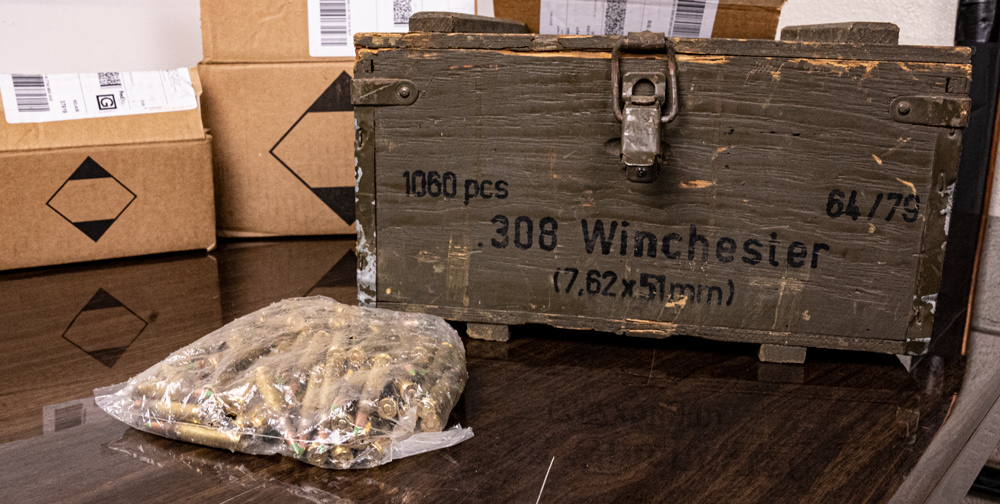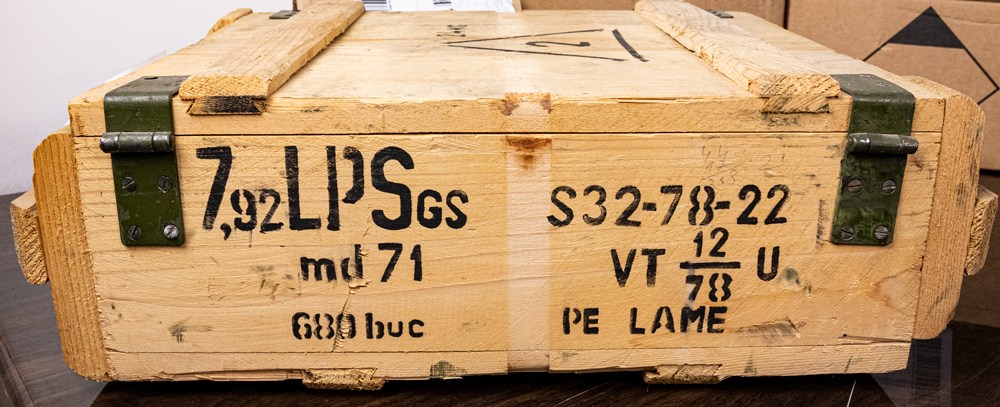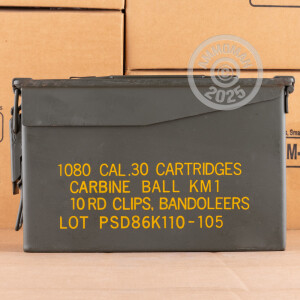Military Surplus

Military Surplus Ammo For Sale
When most people think of military surplus, they picture stores where they can conveniently stock up on gas masks and Ka-Bars in the same place. Some of the matériel that militaries sell to the private market isn’t used or second rate, however. High grade milsurp ammo regularly makes its way to shooters who might only use it for target practice.
History of Military Surplus Ammo

Advantages of Buying Milsurp Ammo
Unlike commercial ammo, surplus ammo is often available in bulk. If you have the money and the space to store tens of thousands of rounds, you can get a great deal on mil-spec ammo. Even purchasing one unit from a retailer’s pallet of foreign milsurp ammo is economical, and those cartridges may come in airtight packaging. Spam cans full of 7.62x39 frequently cross the ocean, which are sealed to meet the needs of even the most cautious preppers. Military surplus ammo is designed to function perfectly in the weapon it is made for. Although milsurp 303 British is increasingly rare, chambering it in a classic Lee-Enfield will let you experience precisely how British troops fired their rifles over one century ago. Furthermore, buying ammunition that originated in a country so exotic as Ethiopia is neat in and of itself.Cons of Buying Surplus Ammo

The Takeaway on Military Surplus
Military surplus ammo can be every bit as good, if not better than, commercial ammunition. It can be worse as well, if it is decades old and was stored in poor conditions. The availability of foreign milsurp ammo depends on too many factors to rely on it with any confidence, but at least domestic producers manufacture mil-spec American cartridges like 50 BMG and 5.56x45 at a steady pace. Its generally consistent quality and bulk pricing make milsurp ammo a good investment to most shooters. If you are happy with Berdan primers and full metal jackets, and even spaghetti-like cordite propellant on occasion, don’t pass up on milsurp!Latest Reviews
-

-
 38 SPECIAL MAGTECH 158 GRAIN LRN (50 ROUNDS)I know most people know that one can turn these poor for defense rounds into a decent protective round, just takes a hand drill and a sharp knife you dont care that much about. Drill a hollowpoint cavity into the nose of the bullet then simply cut a cross into the round with the newly made hollowpoint as its center. Peels back pretty well in milk jugs full of water with a pair of cut offs over the first jug. In these days of very hard to find .38spcl anything one can take a few seconds per round and make what should normally be relegated to only practice rounds into an "if you have to" self defense load. To be honest though the .38spcl is pretty much obsolete with a large number of .380 rounds equaling or surpassing the old round in defensive effectiveness(09/09/2021)
38 SPECIAL MAGTECH 158 GRAIN LRN (50 ROUNDS)I know most people know that one can turn these poor for defense rounds into a decent protective round, just takes a hand drill and a sharp knife you dont care that much about. Drill a hollowpoint cavity into the nose of the bullet then simply cut a cross into the round with the newly made hollowpoint as its center. Peels back pretty well in milk jugs full of water with a pair of cut offs over the first jug. In these days of very hard to find .38spcl anything one can take a few seconds per round and make what should normally be relegated to only practice rounds into an "if you have to" self defense load. To be honest though the .38spcl is pretty much obsolete with a large number of .380 rounds equaling or surpassing the old round in defensive effectiveness(09/09/2021) -
 30 CARBINE KOREAN MILITARY SURPLUS 110 GRAIN FMJ (1080 ROUNDS IN AMMO CAN)12-22-2020 received korean 30 carbine ammo in can. Ammo can looked like new. It took a little time to get can open. It was sealed 100% and ammo in bandoleers looked really nice. Head stamp date was 1986. Totally satisfied, just have to get to the range to try some of this ammo.(12/24/2020)
30 CARBINE KOREAN MILITARY SURPLUS 110 GRAIN FMJ (1080 ROUNDS IN AMMO CAN)12-22-2020 received korean 30 carbine ammo in can. Ammo can looked like new. It took a little time to get can open. It was sealed 100% and ammo in bandoleers looked really nice. Head stamp date was 1986. Totally satisfied, just have to get to the range to try some of this ammo.(12/24/2020) -
 30 CARBINE KOREAN MILITARY SURPLUS 110 GRAIN FMJ (1080 ROUNDS IN AMMO CAN)Just got my 3rd can delivered. Again, prompt delivery and the can, ammo and bandoliers are in great shape. Another range day tomorrow with the carbine.(10/13/2020)
30 CARBINE KOREAN MILITARY SURPLUS 110 GRAIN FMJ (1080 ROUNDS IN AMMO CAN)Just got my 3rd can delivered. Again, prompt delivery and the can, ammo and bandoliers are in great shape. Another range day tomorrow with the carbine.(10/13/2020) -
 30 CARBINE KOREAN MILITARY SURPLUS 110 GRAIN FMJ (1080 ROUNDS IN AMMO CAN)First can was PSD 84. Totally fine and good to go. Second can was KI81. Still pretty good, but about 10-15% of the rounds had some light corrosion on the brass and some small rust spots on the stripper clips. This did not affect function at all. Both cans arrived next day after order, so lightning fast shipping. Still a good deal and I am ordering can #3 tomorrow.(10/12/2020)
30 CARBINE KOREAN MILITARY SURPLUS 110 GRAIN FMJ (1080 ROUNDS IN AMMO CAN)First can was PSD 84. Totally fine and good to go. Second can was KI81. Still pretty good, but about 10-15% of the rounds had some light corrosion on the brass and some small rust spots on the stripper clips. This did not affect function at all. Both cans arrived next day after order, so lightning fast shipping. Still a good deal and I am ordering can #3 tomorrow.(10/12/2020) -
 30 CARBINE KOREAN MILITARY SURPLUS 110 GRAIN FMJ (1080 ROUNDS IN AMMO CAN)First off , super delivery, ordered on a Friday, delivered Saturday. Ammo can perfect on outside, no dents rust or corrosion. Opened can, no musty smell, just the rubber gasket smell. The ammo, made in 1981, clean and bright, looks like it was just packaged. have not cronoed yet, will test against my remaining 1951 Lake City ammo. It's been a while since I ordered from Ammoman., but service great as always. If you have an M1 carbine this is too good of a deal to pass up. Overall I rate service and product A+.(10/10/2020)
30 CARBINE KOREAN MILITARY SURPLUS 110 GRAIN FMJ (1080 ROUNDS IN AMMO CAN)First off , super delivery, ordered on a Friday, delivered Saturday. Ammo can perfect on outside, no dents rust or corrosion. Opened can, no musty smell, just the rubber gasket smell. The ammo, made in 1981, clean and bright, looks like it was just packaged. have not cronoed yet, will test against my remaining 1951 Lake City ammo. It's been a while since I ordered from Ammoman., but service great as always. If you have an M1 carbine this is too good of a deal to pass up. Overall I rate service and product A+.(10/10/2020) -
 30 CARBINE KOREAN MILITARY SURPLUS 110 GRAIN FMJ (1080 ROUNDS IN AMMO CAN)Ordered 2 cans which arrived promptly. The ammo, speed strips and even the bandoliers were in excellent condition. I plan on shooting some in the next week. If it shoots half as good as it looks I’ll be pleased.(09/29/2020)
30 CARBINE KOREAN MILITARY SURPLUS 110 GRAIN FMJ (1080 ROUNDS IN AMMO CAN)Ordered 2 cans which arrived promptly. The ammo, speed strips and even the bandoliers were in excellent condition. I plan on shooting some in the next week. If it shoots half as good as it looks I’ll be pleased.(09/29/2020) -
 30 CARBINE KOREAN MILITARY SURPLUS 110 GRAIN FMJ (1080 ROUNDS IN AMMO CAN)I have not had any experiences with the 2 cans I purchased like a few other folks. Ammo, clips and bandoliers that were shipped to me are in A+ shape. They all look like brand new production. If I wanted to quibble over anything, one of the ammo cans had an obvious repair to the grab handle. Whoop-de-do! Not going to stop me from ordering more when I need it.(06/27/2020)
30 CARBINE KOREAN MILITARY SURPLUS 110 GRAIN FMJ (1080 ROUNDS IN AMMO CAN)I have not had any experiences with the 2 cans I purchased like a few other folks. Ammo, clips and bandoliers that were shipped to me are in A+ shape. They all look like brand new production. If I wanted to quibble over anything, one of the ammo cans had an obvious repair to the grab handle. Whoop-de-do! Not going to stop me from ordering more when I need it.(06/27/2020) -
 30 CARBINE KOREAN MILITARY SURPLUS 110 GRAIN FMJ (1080 ROUNDS IN AMMO CAN)Ammo is as new as when it was made (1985) and put in the .50 cal steel ammo can. Haven't fired any of it yet, but will soon. I'm sure it will shoot as good as it looks. Stripper clips and bandoliers are a bonus with this ammo. I doubt you could reload for the price of this excellent surplus ammo.(05/27/2020)
30 CARBINE KOREAN MILITARY SURPLUS 110 GRAIN FMJ (1080 ROUNDS IN AMMO CAN)Ammo is as new as when it was made (1985) and put in the .50 cal steel ammo can. Haven't fired any of it yet, but will soon. I'm sure it will shoot as good as it looks. Stripper clips and bandoliers are a bonus with this ammo. I doubt you could reload for the price of this excellent surplus ammo.(05/27/2020) -
 30 CARBINE KOREAN MILITARY SURPLUS 110 GRAIN FMJ (1080 ROUNDS IN AMMO CAN)Can and ammo, strippers and bando all in good shape.(05/10/2020)
30 CARBINE KOREAN MILITARY SURPLUS 110 GRAIN FMJ (1080 ROUNDS IN AMMO CAN)Can and ammo, strippers and bando all in good shape.(05/10/2020)
